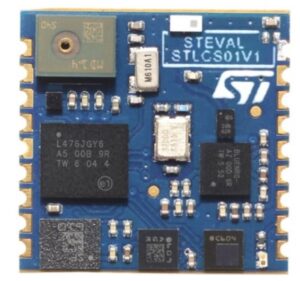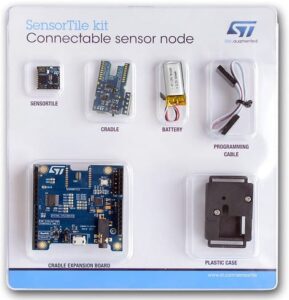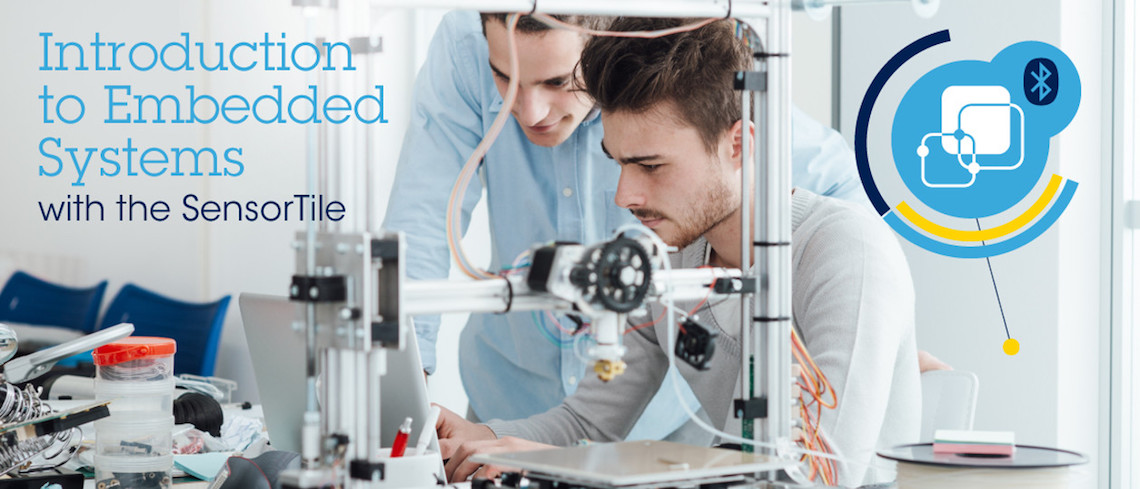Introduction to Embedded Systems with SensorTile is the first freshmen course on real-time IoT embedded computing platforms to use the ST SensorTile as its primary teaching tool. Initially developed and taught by Professor William Kaiser at UCLA, it is now available to all online. Our lives are increasingly governed by embedded systems, and it’s almost impossible to go a week on this blog without reading about an ST all-in-one solution, or how we help you better design for them. However, beyond the simple requirement of combining hardware architectures with software solutions, engineers must also have robust multidisciplinary expertise beyond the boundaries of the product itself. From understanding biology to properly design a heart rate and biometric monitor to grasping the intricacies of sports to better analyze them, the next technological leader will have to be a jack of all trades and master of all.
This is precisely why Introduction to Embedded Systems with SensorTile is the ultimate launching pad for anyone wishing to understand the fundamentals that govern such products. Professor Kaiser first built tutorials and submitted them to a trial group to gauge their feedback before turning the material into a full-blown freshman course that he taught last fall 2017 at UCLA.
In partnership with ST, the curriculum is now available online in the form of eight tutorials that range from setting up your Integrated Development Environment (IDE) to signal processing, firmware programming, and extracting data through Bluetooth Low Energy (LE). However, despite the sometimes complicated subject matter, the course attracts students and makes them passionate by presenting them with real-world problems and meaningful solutions that can actually end up enhancing lives. With this blog post, we’re aiming to offer a first look at this introductory course while sharing the two life lessons we learned along the way.
What Is SensorTile and Why Use It in This Course?

In a nutshell, SensorTile is the world’s densest sensor board. It’s a module known as STEVAL-STLCS01V1 that combines an STM32L476 microcontroller with the LSM6DSM inertial sensor, the LSM303AGR eCompass, the LPS22HB barometer, the MP34DT04 MEMS microphone, and the BlueNRG-MS Bluetooth network processor. What’s even more impressive is that all of these components fit on a board that’s only 13.5 mm x 13.5 mm, which is smaller than a regular US postage stamp. To facilitate developments, we offer a SensorTile kit, the STEVAL-STLKT01V1, that includes the module itself, two different types of cradles, depending on your application, and an external battery. The kit is available at major resellers for a suggested price of about US$80.
Hence, SensorTile is an exciting introduction to embedded systems because it’s affordable and it uses most of the components that we find today on these types of solutions. The sensors and processors are also easily accessible thanks to ST’s documentation and open source code. Additionally, the beauty of the online course resides in its ability to make use of so many of the board’s features while keeping the material easy to understand.
For instance, as early as Tutorial 2, the course delves into sample rate and data rate as well as acquiring and manipulating information from the accelerometer, without demanding an extensive knowledge of C from the user. In fact, the coursework guides the students in opening source files and manipulating code so they can understand what’s going on, even if it’s their first class using C. Furthermore, a table at the end of Tutorial 2 also helps them experiment with the accelerator and the gyroscope by offering a list of possible parameters, making the course not only intuitive but fun, as it encourages experimentation.
Lesson 1: You’re Smarter and More Capable Than You Think
To understand the course better we sat down with Professor Kaiser, winner of the 2007 Gold Shield Prize, the current director of Actuated Sensing & Coordinated Embedded Networked Technologies research group at UCLA, and the first to ever hold a freshman course using SensorTile. When asked what he got out of teaching this class, he told us:
“An important step was to demonstrate how capable our students are, even when they may lack prior experience in computer engineering. While the course is always a challenge, we anticipate that students encountering this technology for the first time can make rapid progress, truly learn, and benefit from new inspiration and understanding of embedded computing and IoT.”

Given the course’s impact, UCLA is making it a requirement for all computer engineering students, ensuring that the SensorTile platform becomes the first introduction to embedded systems for the next generation of leaders. Hence, regardless of your background or familiarity with embedded systems, you too can acquire the knowledge and confidence to develop your own project. You will also come out with a better appreciation of C code programming and how to develop new solutions. As a result, the course is empowering because it teaches us that we can do more than what we initially thought possible.
Professor Kaiser noted that the most significant challenge when learning embedded systems is a roadblock that hinders progress due to a lack of guidance resources. This leads to frustration and a loss of motivation. However, by using SensorTile, students mitigate this risk thanks to their ability to freely ask questions and get support from the ST Community, or find answers using the many resources already online. Furthermore, the team will continue to expand the curriculum and add more content to further enrich the students’ experience.
Lesson 2: You’ll Never be as Ready as You Are Today

Before starting the course, we advise that you get your hands on the SensorTile Kit, a NUCLEO-L476RG or similar NUCLEO board, a Windows or macOS computer with two USB ports (or a hub), one micro USB cable, and one mini USB cable. Additionally, the course will require access to the Internet, and the tutorials on Bluetooth will call for a simple Linux machine, like a BeagleBone or Raspberry Pi.
Simply put, the barrier to entry is minimal, as these products are readily available worldwide and inexpensive. Furthermore, since the coursework is self-explanatory, you will never be as ready as you are today. There are no prerequisite classes, only the burning desire to change people’s lives with technology and see ideas come to life.
Your Gateway to the Industry
Finally, the coursework also has the advantage of exposing students to popular industry tools since the curriculum uses ST’s open source algorithms and development solutions. For instance, Tutorial 8 covers the use of FP-SNS-ALLMEMS1, an ST Function Pack that many in the industry use for prototyping or optimization purposes and that we often encounter in products that companies showcase in trade events or venues like our Developers Conference. Students will also download a specific firmware for the course to ensure that they have an optimal experience, free of bugs or discrepancies between what they see on their screen and what’s on the curriculum. However, since the firmware is just a slightly older version of the microcode, instead of something custom, students that complete the course will have no problem transitioning to the latest firmware version once they start their own project.
Which leads us to a simple question: what will you do once you graduate from Introduction to Embedded Systems with SensorTile? Let us know in the comments section below.
